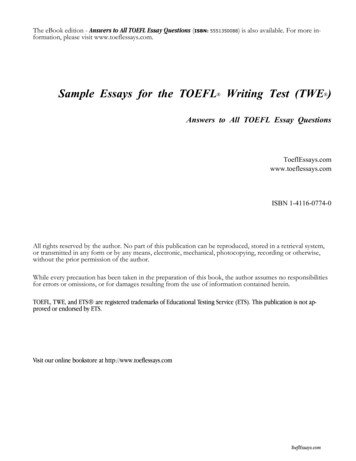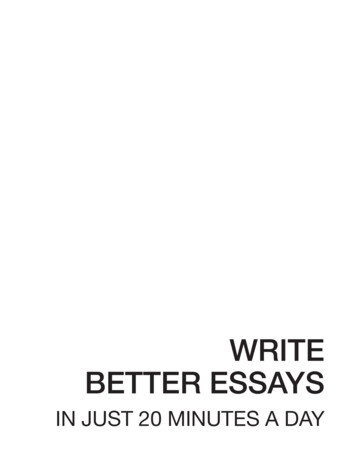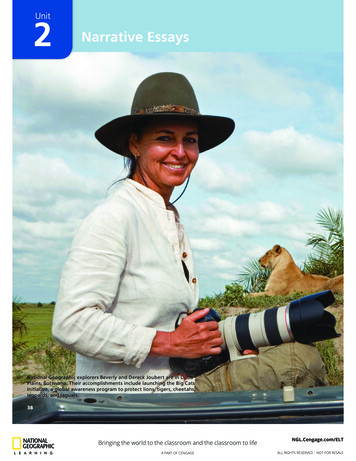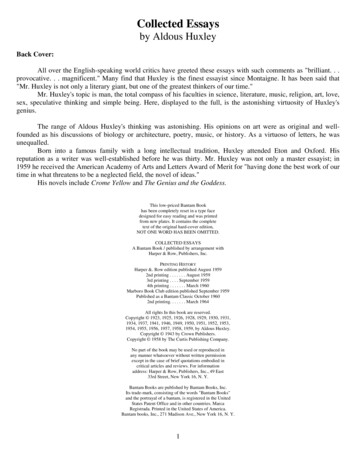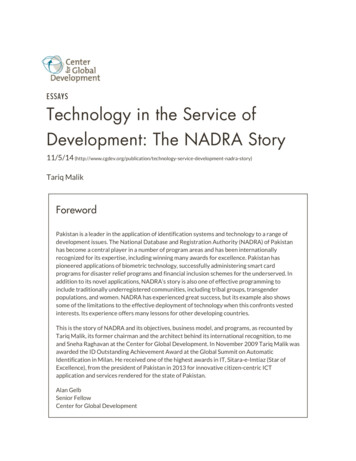
Transcription
ESSAYSTechnology in the Service ofDevelopment: The NADRA Story11/5/14 ce-development-nadra-story)Tariq MalikForewordPakistan is a leader in the application of identification systems and technology to a range ofdevelopment issues. The National Database and Registration Authority (NADRA) of Pakistanhas become a central player in a number of program areas and has been internationallyrecognized for its expertise, including winning many awards for excellence. Pakistan haspioneered applications of biometric technology, successfully administering smart cardprograms for disaster relief programs and financial inclusion schemes for the underserved. Inaddition to its novel applications, NADRA’s story is also one of effective programming toinclude traditionally underregistered communities, including tribal groups, transgenderpopulations, and women. NADRA has experienced great success, but its example also showssome of the limitations to the effective deployment of technology when this confronts vestedinterests. Its experience offers many lessons for other developing countries.This is the story of NADRA and its objectives, business model, and programs, as recounted byTariq Malik, its former chairman and the architect behind its international recognition, to meand Sneha Raghavan at the Center for Global Development. In November 2009 Tariq Malik wasawarded the ID Outstanding Achievement Award at the Global Summit on AutomaticIdentification in Milan. He received one of the highest awards in IT, Sitara-e-Imtiaz (Star ofExcellence), from the president of Pakistan in 2013 for innovative citizen-centric ICTapplication and services rendered for the state of Pakistan.Alan GelbSenior FellowCenter for Global Development
ContentsForeword . 1My Inspiration for NADRA. 2The Origins of NADRA. 2NADRA’s Financial Model . 4How We Increased NADRA Registration Rates – Especially for Women. 5Towards More Sophisticated Smart Cards—and Universal Financial Inclusion . 7Identification for Social Protection . 8Internally Displaced People . 8Flood Relief . 10The Benazir Income Support Program (BISP) . 11Developing Payments Mechanisms for Social Transfers . 12Increasing Birth Registration . 12Elections with Integrity . 13National Security Applications . 17Strengthening Tax Collection . 18Pensions, Payrolls, and Prisons . 18The Approach to Privacy. 19Current and Potential Future Projects . 21Exporting the NADRA Model: Bidding for Foreign Projects . 22Conclusion: Optimizing Governance with Biometrics and InformationTechnologies. 23
ForewordPakistan is a leader in the application of identification systems and technology to a range ofdevelopment issues. The National Database and Registration Authority (NADRA) ofPakistan has become a central player in a number of program areas and has beeninternationally recognized for its expertise, including winning many awards for excellence.Pakistan has pioneered applications of biometric technology, successfully administeringsmart card programs for disaster relief programs and financial inclusion schemes for theunderserved. In addition to its novel applications, NADRA’s story is also one of effectiveprogramming to include traditionally underregistered communities, including tribal groups,transgender populations, and women. NADRA has experienced great success, but itsexample also shows some of the limitations to the effective deployment of technology whenthis confronts vested interests. Its experience offers many lessons for other developingcountries.This is the story of NADRA and its objectives, business model, and programs, as recountedby Tariq Malik, its former chairman and the architect behind its international recognition, tome and Sneha Raghavan at the Center for Global Development. In November 2009 TariqMalik was awarded the ID Outstanding Achievement Award at the Global Summit onAutomatic Identification in Milan. He received one of the highest awards in IT, Sitara-eImtiaz (Star of Excellence), from the president of Pakistan in 2013 for innovative citizencentric ICT application and services rendered for the state of Pakistan.Alan GelbSenior FellowCenter for Global Development1
My Inspiration for NADRAIn early 2008 I was working in the United States in the area of ICT when I was invited toaccompany Benazir Bhutto on her fateful journey to Pakistan as an election observer. Aftershe was killed in a murderous attack, I returned to the United States, reviewed her e-mails,and thought deeply about my various talks with her. I noted 10 points on which sheintended to take action if she came to power.Benazir recognized that there was a trust deficit between citizens of Pakistan and the stateand wanted to eliminate it. This involved, first, establishing a one-to-one relationshipbetween citizen and the state. Second, she sought to empower women; third, to strengthennational security; and, fourth, to build a positive image of the country. Reflection on candidtalks with her revealed a deep desire that she also wanted to strengthen democracy; improvegovernment service delivery; reform governance; manage disasters effectively; combatcorruption; and introduce transparency and combat crime.It was said that Benazir might not have been killed had she not stood up in her car. This wasa powerful metaphor for me – despite the risks, should she not have stood up for herobjectives? Hers were objectives I believed in also. I realized that I wanted to find an avenueto implement them, so I started looking for jobs in Pakistan. One had become available inthe National Database and Registration Authority (NADRA) as general manager ofnetworks. In April 2008 I applied and was interviewed by the board of director generals andappointed, but when I joined they decided that I was overqualified. Within three months,they promoted me to the position of head of technology or deputy chairman. I presentedthese 10 objectives to the board and explained that NADRA could use its expertise in dataand systems and could make a difference by setting our goals around these objectives. Iargued that we should address each one by developing a technology product to address it.The board agreed, and I was given full authority to move forward.The Origins of NADRATo recap a little, Pakistan’s first registration office was established by Zulfikar Ali Bhutto,Benazir's father, in 1973 under Article 30 of the Second Amendment of the constitution ofPakistan to perform identification and maintain the statistical database of the citizens ofPakistan. It was stipulated that every person should have a state-issued ID. When I reviewedold documents, I was amazed – he did not want only an ID document to simply recordevidence of identity (EOI), but a system that provided an automatic census for informeddecision making and to improve strategic planning for the country. In 1973, in aparliamentary session, Bhutto stated in parliament to the people of Pakistan, “Due to theabsence of a full statistical database of the people of this country, this country is operating inutter darkness.” The government started issuing national identity card (NIC) numbers to itscitizens in 1973. His vision was, in fact, not too different from the 10 points expressed by hisdaughter.2
In 1998 the Nawaz Sharif government took the initiative to conduct the door-to-door censusof Pakistan with the help of the Pakistan army. In 1999 the Pakistan army startedcontemplating merging two institutions, the Directorate General of Registration Pakistan(DGR) and the National Database Organization (NDO), to computerize census datacollected and use it to issue computerized cards. A NADRA ordinance was promulgatedwith ID forms, ID cards rules, and regulations. Preparation began in 2000, but from 2000 to2002 the program experienced difficulties. The “NADRA ordinance” came into being onMarch 10, 2000, by finally merging the DGR and NDO, and was introduced with the aim ofreducing government interference in the process of registering people. The ordinance iscomprehensive; it lays out a blueprint for how to register individuals. The government alsoprovided some seed money on loan to enable NADRA to become financially self-reliant.Registration was voluntary at the time and covered only adults 18 or above. They recordedmanual thumbprints, but this proved to be inadequate for accurate identification. It was apaper-based personal identity system. Pakistan had many Afghan refugees, who started topour in from 1979, and Bengalis dating from the 1971 separation of Bangladesh; there werealso many Iranians living in the country. Many Afghans were able to obtain ID cards bydeceiving the paper-based system, and there was no easy way to distinguish these false cardsfrom the real ones. The years between 2001 and 2005 saw serious problems in the area ofidentification. Many genuine Pakistani citizens were without ID cards, many nonnationalspossessed national ID cards, and there were many fake identities.In response to these difficulties, my predecessor, Brigadier Saleem Moeen, had startedresearching the deployment of digital biometric technology, and by 2007 he had built a goodfoundation for a stronger system. The database was run in batch mode; if a person appliedfor an ID card, the batch to process the application ran during the night, comparing thecaptured thumbprints of the new applicant against the legacy data. The program imposedsome basic business rules, for example, that the age of a person should be less than theduration of the marriage of his or her parents.By 2008, we improved the data architecture to include the full set of 10 fingerprints and adigital photograph. This technology was powerful enough to enable full de-duplication ofthe national database and greatly reduced the prevalence of dual identities and identity theft.We asked the people to register and framed this in terms of a strategic partnership with thestate, which in turn would recognize them as citizens. Registration was still technicallyvoluntary, but people could not open a bank account without an ID card or obtain apassport or enter into any transaction with the state. An ID card was also needed to obtain agas or electricity connection and to pay utility bills. These requirements made it very difficultto function without enrolling and caused people to register. By virtue of his post, thechairman of NADRA is also the registrar general of Pakistan, whose signature is on everyID. When I took over, NADRA was still based on an ordinance, but I requested parliamentto approve it, and it became an act of parliament, under the 18th Amendment of theconstitution. NADRA was lucky and blessed by very competent chairmen. I would give3
credit to Major General (Retd.) Zahid Ehsan, Brigadier (Retd.) Saleem Moeen, and AliHakeem for laying out the solid foundations of NADRA.NADRA’s Financial ModelNADRA desperately needed a viable financial model. When I joined NADRA, it was leftwith only two months of salary. We decided that we would not ask for regular budget or forloans from the government as this would open the door to political interference. Instead, wewould request a service fee rendered to the government and use our earnings to provide across-subsidy to the poor people of Pakistan to enable them to register free of cost. Firsttime applicants for an ID card would get the card free, but expedited service, within twoweeks, would cost 1,100 rupees. We now earn money for a wide range of domestic services.For example, we charge banks around 35 rupees a head for authenticating an individual atthe time of opening a bank account. Each individual fee is small, but when you have 55million transactions, the amount generates significant income and in a sustainable way.The business model has been very successful. In 2012–13 revenues were three times theirlevel in 2007–8. NADRA now has 18,000 employees, 537 static registration centers, 15registration centers for overseas Pakistanis, 236 mobile vans, and 74 semimobile units. Weoperate two data centers 150 miles apart, and a third one is planned to ensure that our data issecure. We run about 1,000 servers connected to 9,000 computers. We have issued 120million identities and 97 million ID cards; the difference is the children, an area where we arestill lagging. Our digital gallery includes 118 million facial images and 503 millionfingerprints, making it one of the world's largest multi-biometric databases.A public company was formed, NADRA Technologies Limited, registered with theSecurities and Exchange Commission of Pakistan. It is wholly owned by NADRA and ableto bid for contracts outside the country and earn revenues which could be plowed back tosupport our operations. We compete successfully for international contracts – income fromforeign projects alone came to 17.6 million US dollars in 2013, which allowed us to furtherupgrade our infrastructure. In the last six years, we have been able to reinvest in ourtechnology without accepting a regular budget from the government of Pakistan.We also focus on employee incentives. I wanted people to be committed to working forNADRA, so we offered salary increases by creating a sliding scale salary structure that wasbetter than that of the government. I introduced a reward and recognition system in whichNADRA officers had incentives not to be involved in identity theft. One form of corruptionin NADRA was that staff would often accept money in exchange for a token to jump aheadin a service line. To counter this, we created the system for fast-track service at a cost of1,100 rupees and linked it to payments to payments to staff, who received bonuses frommoney collected through this system, as an incentive. . Staff could also boost their pay byfacilitating more transactions. Unlike government offices, they could keep NADRA officesopen for as many hours as they wanted, subject to the manager’s discretion. Between 20084
and 2013 the average salary at NADRA had increased by 131 percent. It is a perfect examplehow a just reward and recognition system can improve service delivery.How We Increased NADRA Registration Rates – Especially forWomenIn 2008 our rates of registration were not high enough to provide comprehensiveidentification. As soon as our resources allowed, I therefore made it a point to increase ourrepresentation to ensure that there would be an office in every district. We also made surewe would have the technical infrastructure to allow our mobile vans to go into far-flungareas to collect and transmit enrollment data on a daily basis, by making use of satellitecommunications. The static centers and van and semimobile units were organized into eightregions, each of which was headed by its own data infrastructure office, transmitting databack to the centralized database, which was located in Islamabad. This big data infrastructurethrough which the information could be exchanged with headquarters was named the DigitalVideo Broadcast System (DVBRCS).Using this organization and technology, we rapidly increased registration from 54 million in2008 to 98 million in 2014, including around 55 million men and 43 million women. Whileoverall registration increased by 80 percent, the increase for women was 104 percent, relativeto 65 percent for men. I made it a point in the registration campaign to stress thatregistration for women empowers them. If they wanted to be counted – as Benazir Bhuttohad wanted – they had to let us count them. Overall we were very successful, but we facedsome serious obstacles. In some regions we had to deal with the Taliban. We had to dealwith terrorists. We had areas where a long-standing culture of male chauvinism wouldprevent people from letting us register women. Men would hold the hands of the womenduring registration, or not let us register them at all. I was persistent and sought to removethese objections. For example, we established 15 women-only registration centers, where allthe staff were women, from the data entry operator to the manager. I would even send vanswith women drivers to go into hujiras (area reserved for women only in a house) or areasruled informally by warlords.We incentivized women to register by making clear that if they were poor, they would beeligible to receive a subsistence grant from the Benazir Income Support Program (BISP) – afinancial inclusion program geared towards the poorest of poor women. For a woman toregister for BISP, they would need to register with NADRA for an ID card. They would alsoneed this ID card if they wanted to go on their hajj pilgrimage, as it was a prerequisite tosigning up for a passport. Similarly, we educated them on the need for ID to be able toexercise the vote, which involved running a campaign to assure them that they could votehow they wanted, even against the will of their husbands, and even when their husbandswere not present. Many were thrilled to learn of these possibilities. When the first center wasopened in Mardan, a region affected by the war, 3,000 women turned up on the first day.5
To achieve universal coverage, we had to penetrate remote areas, beyond the reach of evenmobile vans. We introduced motorcycle registration units and, where motorcycles could notgo, man-pack units – I hired hikers, mountaineers, and skiers who could go into mountainareas and talk to the people there. Many living in rural mountainous communities did not seethe need for an ID card because they had not interacted with the state in years. They werenot interested in buying property or even going down the mountain to visit the towns.Through the hikers and mountaineers we explained that they could be eligible for socialtransfers and that, if needed, we would even open a BISP office on the mountain. We alsoexplained that in the event of a disaster such as the 2005 earthquake, the government coulduse the ID system to provide a subsistence allowance. Once they understood the linkbetween identification and social protection, they came in droves to register. We had to hiremore mountaineers and hikers. It is pertinent to mention here that from June 2008 toDecember 2013, approximately 30 million Pakistanis got their ID cards free of cost.In the process, we found some places where the state was totally absent. Azuchi, forexample, was discovered by air force pilots in the foothills of the Kirthar Mountains.NADRA was activated and registered them quickly. They were thrilled as it was the first timethe state actually bonded with them through the ID card. NADRA is often the first and onlygovernment office in certain districts, as we are present in areas that lack post offices, policestations, or any other representative offices of the government. To cite another example,Baluchistan experienced a tragic earthquake last year. We were the first responders becausewe had an office there, as well as mobile vans.In addition to issuing general national ID cards in Pakistan, we issued special cards tocitizens with special needs on the advice of the president, Asif Ali Zardari. We also wantedto document our diaspora. We registered 6.3 million identities of overseas Pakistanis throughour embassies. This NICOP (National Identity Card for Overseas Pakistanis) card entitlesthem to transact with Pakistan and has some additional benefits. Similarly, the “PakistanOrigin Card” is issued to Pakistanis living abroad in states such as Germany and France thatdo not allow dual citizenship. They can transact with the government and enter visa-freedespite relinquishing their Pakistani citizenship.NADRA empowered minorities, as well, by easing registration for them. For example,Hindu marriages were recorded with the help of Mukhis (community leaders). Christianbaptismal certificates were also accepted for registration. Similarly, Pakistan became the firstMuslim country that allowed eunuchs to declare their identity as such (Khawaja Sara). Allminorities are on voter lists, as well, and have equal voting rights. NADRA has empowered1.3 million Hindus, 1.2 million Christians, and about 50,000 Sikhs, Buddhists, Parsis, Jews,and other minorities in the last four years. While registering minorities, my message was becounted, exercise your vote, and have your say in your Pakistan!6
Towards More Sophisticated Smart Cards—and Universal FinancialInclusionThe Pakistani diaspora cards needed to be compliant with ICAO standards (9303 Volume 2)and with sufficient security features to be difficult to forge and hard to use for illegalpurposes, such as human trafficking, illegal immigration, or other criminal acts throughidentity theft. I wanted to introduce the best identity document in the world. I researchedand found that the German ID card was the best and at the time the most advanced cardavailable. It became my passion to make Pakistan’s ID card more secure than the GermanID card, which has 28 security features; ours was designed to have 36 features. The contentson the face of the card are also in its chip; it has three ghost images, a machine-readable zone(MRZ), the flag includes microtext, and the colors change when the card is tilted.The operating system on the chip was written by our own NADRA engineers indigenously.It is a passive chip, so it is not possible to track the owner. The chip includes a match-onapplet that stores and matches the four best fingerprints and the digital photograph on thechip. The system is very secure; when you match information from the chip, it does notleave the chip itself. All you know is whether or not it matches, based on the applet. Thisgives confidence to card owners that their information is under their control, and they havethe authority to allow access to this information for a service or product that they areentitled to. The card has other technical features and also provides a platform through whichservices can be delivered. These services can be enrolled through digital certificates, PIN,and token methodology. These include financial services – Pakistanis living abroad can sendremittances by partnering with banks as an alternative to the “Hawala and Hundi System”(undocumented system), where all too often undocumented money is sent to terrorists. Thecard satisfies the Know-Your-Customer (KYC) requirements of the State Bank of Pakistanfor secure money transfer.With programs like social protection and health insurance in mind, we then moved tointroduce a similar smart card for citizens inside Pakistan. I introduced the Smart NationalIdentity Card (SNIC) in October 2012 to convert Benazir’s dream of secure identificationfor biometrics-based voting, pension disbursement, social and financial inclusion programs,and other services like health insurance and keeping track of whether children are vaccinatedor are not. This can be an effective vehicle to strike a strategic partnership between the stateand citizens in a meaningful way. It can revolutionize governance by cutting intermediarychannels and bureaucracy. As an incentive, we partnered with a national insurance company,the State Life Corporation of Pakistan, to offer insurance against accidental death for anominal charge built into the ID card fee. I ran a campaign, offering citizens the choice of asimple plastic Teslin-based card or the new card with the built-in insurance policy. It was ahuge success. One million people applied for smart cards in just eight weeks. Another sellingpoint was that this card would be accepted as an identity credential in more than 100international airports because it adhered to the ICAO rules for machine-readable traveldocuments.7
Another feature is the QR code on the back of the card. It serves as another security feature:taking a picture of it and running a program decodes it to provide the same information ason the front and back of the card. The QR code also enables the card to be used for otherapplications such as e-commerce; platforms for iPhone applications were being developedwhen I was chairman. It does not require a lot of infrastructure to use; all that is needed is amachine that is capable of reading the card or a mobile phone that has the same capacity. Ihope the current chairman will take it to the next level.I strongly believe that by experimenting with information and biometric technologies andusing NADRA’s citizen database to Pakistan’s competitive advantage, Pakistan has a uniqueopportunity to become the world’s largest and most inclusive digital financial servicesmarket, with every household in the country connected to the integrated digital financialplatform. It is my passion to see this happen, as it would convert Benazir’s dream intoreality. Benazir Bhutto was a strong believer that financial inclusion matters for the welfareof the poorest of the poor and for national economic development, and I believe this, too.Without formal financial services, the poor have to rely on informal mechanisms that areexpensive, unreliable, and often exploitative. NADRA’s smart card solution triggered abranchless banking revolution in Pakistan. Digital financial inclusion must be a priority forthe current government, as leveraging NADRA’s database can enhance its ability to optimizeservice delivery. The State Bank of Pakistan will be better able to monitor suspiciousfinancial transactions when they are under the net of digital transactions, rather than outsidein the untraceable cash economy. With citizen registration soaring to 98 percent, Pakistanhas the necessary ingredients to achieve universal financial inclusion.Identification for Social ProtectionWe soon began to use our ID technology to implement a variety of social protectionprograms. Since most of our beneficiaries were now uniquely identifiable, it seemed like alogical transition to use it in this way. Pakistan had not had a census since 1998, andalthough international organizations often conducted surveys to roll out their programs,there was no mechanism to preserve the data that they collected.Internally Displaced PeopleThe first opportunity came in 2009 when the government launched the military operation“Rah-e-Rast” to take action against terrorists in Swat and Malakand. In the wake of thisoperation, many people had to leave their homes, to be lodged in camps set up bygovernment and welfare agencies and with host families. Many of their houses weredestroyed, and many lost their livelihood. The government estimated the displacement costat around 25,000 rupees per household. The problem was how to deliver assistance withoutpilferage and to offer an assurance to international donors that the money would go tointended beneficiaries. As stressed by the president, the recipients also needed to be able to8
preserve their dignity. This would not be possible if they were expected to wait in long linesfor handouts of rations or clothing.In response, we used the NADRA database, sorting by the address field to identify potentialbeneficiaries in the Swat and Malakand regions. The government had come up with a 3Rstrategy: Relief (immediate), Rehabilitation, and Reconstruction. We calculated that the totalnumber of beneficiaries should be 396,653 and arranged to disburse 25,000 rupees to eachinternally displaced family using debit cards in tandem with biometric verification. Werecorded the thumbprints of all who came to receive the first phase of immediate relief inthe form of in-kind aid. The database had an architecture whereby it was easy to see whoconstituted the direct members of each family, so that we were also able to prevent twomembers of the same family from receiving the entitlement. The system would reject amember of the family who intended to claim assistance if another member of this family hadalready done so.Not surprisingly, many people wanted to change their addresses to Swat in order to qualifyfor aid, so that we received a lot of applications for change of address. To resolve thesecases, we reregistered people living in camps created by the army to ensure that theyqualified. When people were reregistered, their fingerprints were taken again to check ifthere was a match with the citizen database. I also established a rule to the effect that forthose critical three months nobody moving into t
Tariq Malik, its former chairman and the architect behind its international recognition, to me and Sneha Raghavan at the Center for Global Development. In November 2009 Tariq Malik was awarded the ID Outstanding Achievement Award at the Global Summit on Automatic Identification in Milan. He received one of the highest awards in IT, Sitara-e .


